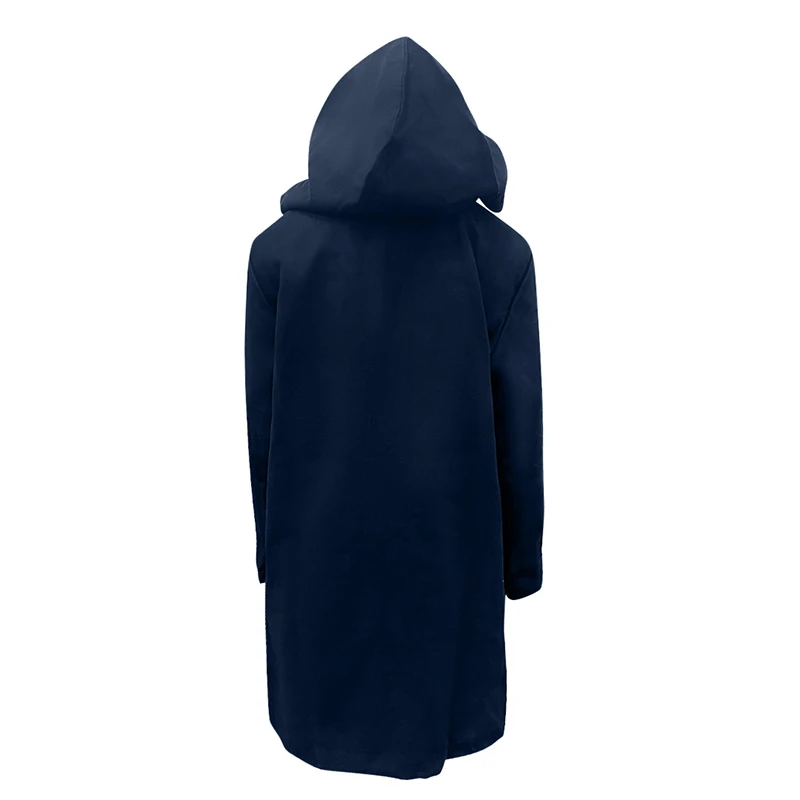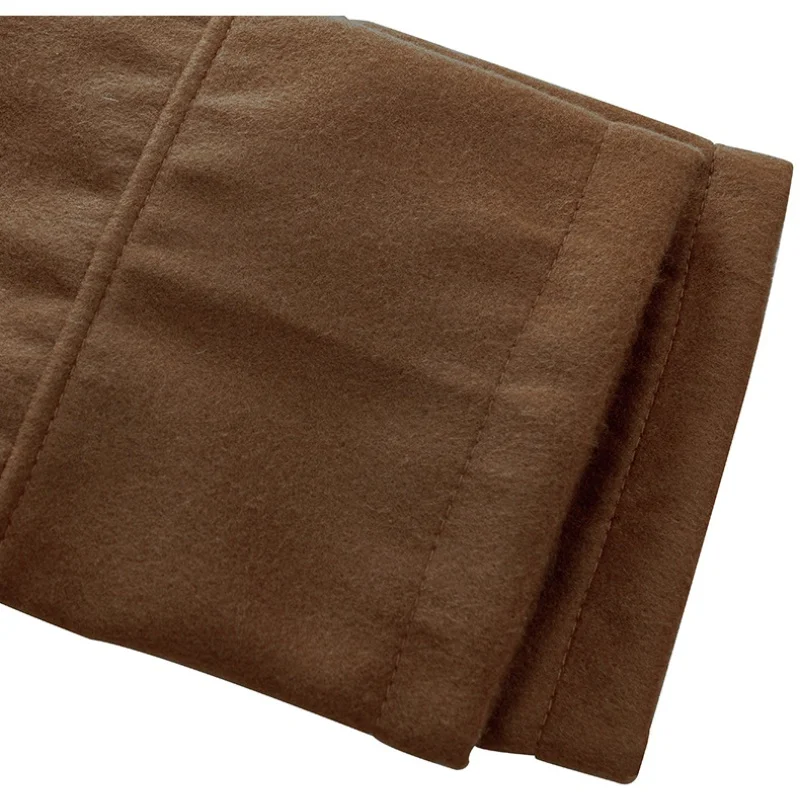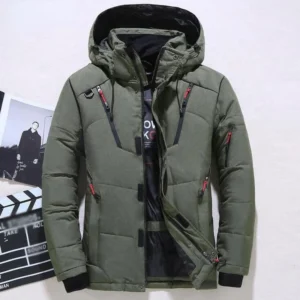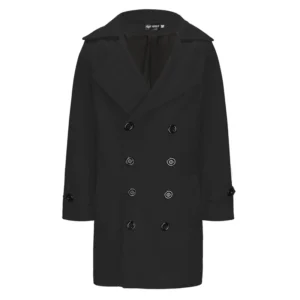The Definitive Answer: Why 100% Wool Excels in Winter Conditions
Yes, a 100% wool coat is indeed an excellent choice for winter weather. The natural properties of wool make it one of the most effective materials for combating cold temperatures, providing remarkable insulation while maintaining breathability that few other materials can match.
What makes wool truly stand out is its unique fiber structure that traps air and creates natural insulation against the cold. This remarkable material keeps you warm even in changing weather conditions, wicks away moisture, and manages to balance functionality with timeless style. Throughout this article, we’ll explore why wool car coats for men have endured as winter staples, how wool performs against other materials, and when it makes the most sense to choose a wool coat for your winter wardrobe. Metro Cloak’s men’s wool coats collection showcases these principles with premium craftsmanship designed for winter performance.
The Science of Warmth: How 100% Wool Protects Against Winter Elements
What makes wool such an effective winter material isn’t just tradition—it’s science. The secret lies in wool’s complex fiber structure. Each wool fiber has a natural crimp that creates thousands of tiny air pockets, providing exceptional insulation by trapping your body heat. This natural architecture explains why wool has been trusted for centuries in the coldest environments.
Wool’s temperature regulation abilities are equally impressive. Unlike synthetic materials that can leave you overheated when moving from outdoor cold to indoor warmth, wool adapts to your body temperature and the surrounding environment. This remarkable breathability is due to wool’s ability to absorb and release moisture vapor, preventing that clammy feeling that often accompanies less breathable materials.
One of the most misunderstood aspects of wool is its relationship with moisture. While not completely waterproof, wool has natural water-resistant properties thanks to lanolin, a waxy substance in the fibers. More impressively, wool coats can keep you warm even when damp—wool can absorb up to 30% of its weight in moisture before feeling wet to the touch, and importantly, it continues insulating even in this state.
The fiber structure of wool also makes it remarkably efficient at wicking moisture away from your body. This means perspiration is moved away from your skin and to the outer surface where it can evaporate, keeping you dry and comfortable. While 70 percent wool coats may offer slightly less insulation than their 100% counterparts, they still provide substantial warmth with the benefit of being potentially more affordable.
Winter Ready: Comprehensive Pros and Cons of 100% Wool Coats
Understanding the full picture of wool’s benefits and limitations helps you make the most informed decision for your winter wardrobe needs.
Advantages of 100% Wool Coats
- Superior insulation: Wool’s crimped fibers create natural air pockets that trap body heat more effectively than most other natural materials.
- Exceptional durability: With proper care, a quality wool coat can last decades, making it a genuine investment piece.
- Versatile style: Few materials transition as seamlessly from casual to formal settings, making wool coats appropriate for nearly any winter occasion.
- Sustainable choice: Wool is renewable, biodegradable, and has a lower environmental impact than petroleum-based alternatives.
- Natural elasticity: Wool fibers can bend up to 20,000 times without breaking, maintaining the coat’s shape and allowing comfortable movement.
- Odor resistance: Wool’s moisture-wicking properties prevent the buildup of odor-causing bacteria, requiring less frequent cleaning.
- Effective breathability: Even while keeping you warm, wool allows excess heat and moisture to escape, preventing overheating.
Disadvantages of 100% Wool Coats
- Weight consideration: Pure wool coats can be heavier than synthetic or down alternatives, which may be noticeable during extended wear.
- Higher price point: Quality wool commands a premium price, with the best wool overcoats representing a significant initial investment.
- Special care requirements: Wool requires more careful cleaning and storage than many synthetics to maintain its properties.
- Limited water resistance: While naturally somewhat water-resistant, wool isn’t waterproof and can become heavy when saturated in heavy rain or snow.
- Potential for pilling: Over time, wool can develop small balls of fiber on the surface, requiring occasional maintenance.
- Not ideal for extreme cold without layering: In the most frigid conditions, wool alone may not provide sufficient protection without proper layering.
Material Matchup: Comparing 100% Wool to Alternative Winter Coat Materials

When selecting the perfect winter coat, understanding how different materials perform can help you make the best choice for your specific needs and environment.
Wool vs. Down
Down offers an unmatched warmth-to-weight ratio, making it incredibly light while providing exceptional insulation in dry conditions. However, down’s greatest weakness becomes apparent when wet—it clumps together, losing nearly all insulating properties. Wool, while heavier, continues insulating when damp, making it more reliable in unpredictable weather. Down also compresses more easily for packing but requires special cleaning considerations similar to wool.
Wool vs. Synthetic Materials
Synthetic coats (using materials like polyester with insulation like Thinsulate or PrimaLoft) often excel in wet conditions with superior water resistance and quick-drying properties. They’re typically more affordable and easier to care for than wool. However, synthetics can’t match wool’s breathability, often causing overheating during activity or when moving between outdoor and indoor environments. Synthetics also contribute to microplastic pollution and lack the biodegradability of natural wool. For understanding the full range of wool coat warmth in winter conditions, consider how different environments affect performance.
Wool vs. Cashmere
Cashmere, derived from specific goats, offers unparalleled softness and is actually warmer than sheep’s wool by weight. However, pure cashmere coats are significantly more expensive than standard wool and less durable for everyday wear. Cashmere typically shows wear faster and requires even more delicate care, making wool the more practical choice for daily winter wear.
Wool vs. Wool Blends
Wool blends (combining wool with synthetics or other natural fibers) attempt to capture wool’s benefits while addressing its limitations. These blends often reduce weight, cost, and care requirements while improving wrinkle resistance. However, as the wool percentage decreases, so do many of wool’s natural benefits—especially insulation, breathability, and moisture management. The ideal blend depends on your priorities: higher wool content (80%+) maintains most natural benefits, while lower percentages may sacrifice performance for convenience.
For extremely cold conditions, specialized down coats might provide better protection, but wool remains the more versatile choice for variable winter conditions.
When to Choose Wool: Ideal Conditions for Your 100% Wool Coat
Understanding when a wool coat performs at its best helps you make the most of this investment piece and know when to reach for alternatives.
Ideal Conditions for Wool Coats
A 100% wool coat excels in temperatures ranging from just above freezing to around 50°F (10°C) when worn with normal clothing underneath. With proper layering, wool coats can remain comfortable down to about 15-20°F (-9 to -6°C) for moderate activity levels. Wool performs exceptionally well in dry cold and can handle light snow or brief rain showers with minimal impact on warmth.
The classic wool coat finds its perfect environment in urban settings—daily commutes, walks between buildings, outdoor social events, and professional settings. Its versatility shines in situations where you’re alternating between indoors and outdoors throughout the day. The best wool overcoats for winter warmth combine substantial weight, tight weaves, and quality construction to maximize these natural advantages.
When to Consider Alternatives
In extremely cold temperatures (below 15°F/-9°C) or during prolonged outdoor activity in freezing conditions, a specialized technical winter coat may be more appropriate, especially without extensive layering. Heavy, sustained precipitation presents another challenge for wool—while it handles moisture better than many materials, extended exposure to heavy rain or wet snow will eventually saturate the fabric, increasing weight and reducing comfort.
High-intensity outdoor activities like winter sports typically demand more technical outerwear with features wool doesn’t provide, such as complete waterproofing, extreme lightweight construction, or specialized ventilation systems. For these scenarios, consider a heavy winter coat designed specifically for extreme conditions.
Layering Strategies: Maximizing Your Wool Coat’s Winter Performance
The true secret to maximizing your wool coat’s winter performance lies in strategic layering. This approach not only enhances warmth but also provides adaptability to changing conditions throughout the day.
Base Layer: Moisture Management
Start with a thin, form-fitting base layer made from moisture-wicking materials like merino wool or technical synthetics. This layer should sit directly against your skin to draw perspiration away from your body. Avoid cotton, which retains moisture and can leave you feeling damp and cold. A good base layer creates the foundation for comfort in any winter condition.
Mid Layer: Insulation
The mid layer provides your primary insulation by trapping warm air close to your body. Lightweight wool sweaters, fleece pullovers, or down vests make excellent mid layers. For extreme cold, consider a thicker sweater or even a lightweight down jacket. The key is choosing something substantial enough for warmth but not so bulky that it restricts movement or creates an uncomfortable fit under your coat.
Outer Layer: Your Wool Coat
Your wool coat serves as the protective shell, blocking wind and providing additional insulation. A well-fitted coat should allow enough room for your layers without feeling restrictive or excessively bulky. The ultimate guide to layering with wool car coats provides detailed strategies for different temperature ranges and activity levels.
Essential Accessories
Complete your winter protection with strategic accessories. A wool scarf not only adds style but seals the vulnerable neck area against cold air. Insulated gloves protect extremities, while a wool hat prevents significant heat loss through your head. These accessories can dramatically extend the temperature range in which your wool coat remains comfortable.
Quality Matters: How to Select a Superior 100% Wool Coat

Investing in a quality wool coat makes all the difference in both performance and longevity. Here’s how to identify a truly superior garment:
Fabric Assessment
Always check the label to verify 100% wool content, though understand that even among pure wool coats, significant quality variations exist. When examining the fabric, look for a tight, even weave with substantial weight—lightweight wool may not provide adequate winter protection. Quality wool has a smooth hand feel with a slight crispness, though different wool types offer varying textures.
Merino wool provides exceptional softness and insulation, while lambswool offers a good balance of durability and comfort. Melton wool, with its tightly woven, almost felt-like finish, excels at blocking wind—ideal for the coldest conditions. The best black wool coats combine these premium materials with classic styling for versatile winter wear.
Construction Quality
Superior construction separates investment pieces from disposable fashion. Examine seams for tight, even stitching with no loose threads. Buttons should be securely attached, ideally sewn with a supportive shank that accommodates the coat’s thickness. Buttonholes should be neatly finished with no fraying.
The lining is equally important—look for smooth, breathable materials like acetate or high-quality synthetics that allow easy movement and add durability. Silk linings offer luxury but may require replacement sooner. Check that the lining is attached properly with no puckering or visible tacking stitches.
Fit Considerations
A quality wool coat should allow room for layering without appearing oversized. The shoulders should align with your natural shoulder line, sleeves should reach the base of your thumb when arms are relaxed, and the body should close comfortably without pulling. For winter performance, consider a slightly longer length that protects the thighs during cold, windy conditions.
Care and Longevity: Maintaining Your Wool Coat’s Winter Performance
Proper care dramatically extends your wool coat’s life and maintains its insulating properties year after year.
Daily Maintenance
After wearing, brush your coat with a soft clothes brush to remove surface dirt and debris. This simple habit prevents particles from embedding in the fibers and causing premature wear. Allow your coat to air out for at least 30 minutes before storing, hanging it on a sturdy wooden hanger that supports the shoulders properly. Avoid wire hangers, which can distort the coat’s shape over time.
Cleaning Guidelines
Most wool coats require cleaning only once or twice per season unless visibly soiled. For minor spots, spot cleaning with a damp cloth and mild soap often suffices. When full cleaning becomes necessary, dry cleaning is typically safest, though look for environmentally friendly cleaners who specialize in natural fibers.
Some high-quality wool coats can be hand washed using cool water and specialty wool detergent, but always check the garment’s care label first. Never wring or twist wet wool—press out excess water between towels and dry flat to maintain shape.
Seasonal Storage
Before storing for the season, ensure your coat is clean and completely dry. Use breathable garment bags rather than plastic, which can trap moisture and lead to mildew. Cedar blocks or lavender sachets serve as natural moth deterrents without the harsh chemicals of mothballs. Store in a cool, dry place away from direct sunlight, which can fade the fabric over time.
The unmatched benefits of wool car coats become even more apparent when proper care extends their performance for many years beyond less durable alternatives.
The Investment Perspective: Evaluating a 100% Wool Coat’s Value
When considering a 100% wool coat, thinking beyond the price tag reveals its true value proposition. Quality wool coats represent a significant initial investment compared to synthetic alternatives, but their economics change dramatically when viewed through a cost-per-wear lens. A well-made wool coat often lasts 10-15 years or more with proper care, while many synthetic options may need replacement after just 2-3 seasons.
The environmental calculation also favors wool. As a natural, renewable, and biodegradable fiber, wool has a significantly lower lifetime environmental impact than petroleum-based synthetics. When a wool coat eventually wears out after many years of use, it will decompose naturally rather than persisting in landfills for decades or centuries.
Perhaps wool’s most compelling economic value lies in its versatility and timelessness. Unlike trend-focused pieces that quickly look dated, a classic wool coat remains stylish year after year, transitioning effortlessly between casual and formal settings. This versatility means your investment serves multiple purposes in your wardrobe, eliminating the need for several specialized coats.
Mens Heavy Winter Coat, Mens Insulated Coat, Mens Parka Coat
Price range: $175.52 through $237.36 Select options This product has multiple variants. The options may be chosen on the product pageMens Big and Tall Winter Coats, Mens Down Coat, Mens Hooded Winter Coat, Mens Puffer Coat
Price range: $126.44 through $217.01 Select options This product has multiple variants. The options may be chosen on the product pageMens Double Breasted Pea Coat, Mens Wool Blend Coat, Mens Wool Pea Coat
Price range: $136.84 through $157.36 Select options This product has multiple variants. The options may be chosen on the product pageMens Cashmere Overcoat, Mens Hooded Winter Coat, Mens Wool Blend Coat
Price range: $128.72 through $139.68 Select options This product has multiple variants. The options may be chosen on the product pageMens Black Overcoat, Mens Black Wool Coat, Mens Wool Overcoat
$339.18 Select options This product has multiple variants. The options may be chosen on the product pageMens Grey Overcoat, Mens Wool Blend Coat, Mens Wool Overcoat
$201.28 Select options This product has multiple variants. The options may be chosen on the product page
While budget considerations are always valid, viewing a wool coat as a long-term investment rather than a seasonal expense often justifies the higher upfront cost. For those unable to invest in 100% wool immediately, quality wool blends can offer a compromise with many of wool’s benefits at a more accessible price point.
Frequently Asked Questions About 100% Wool Coats in Winter

How cold is too cold for just a wool coat?
Without additional layering, most people find a standard wool coat comfortable down to about 25-30°F (-4 to -1°C). With strategic layering (base layer, sweater, scarf, hat), many wool coats can remain effective down to 15°F (-9°C). Below that, you’ll likely want a specialized winter coat or significant additional layers.
Will a wool coat keep me dry in the snow?
Wool naturally repels light snow, which tends to brush off before melting. In steady snowfall, wool will eventually absorb moisture but continues insulating even when damp. For heavy, wet snow or extended exposure, consider treating your wool coat with a fabric protector or opting for a coat with weatherproof outer shell.
How can I tell if a coat is really 100% wool?
Check the label first, but also use the burn test if possible (with an inconspicuous thread): wool smells like burning hair and creates a crushable ash. Wool has a distinctive weight and drape heavier than synthetics. Quality wool also has a slightly crisp yet soft hand feel that’s difficult to replicate with artificial fibers.
Are wool coats itchy?
The itchiness depends on the wool quality and processing. Merino and lambswool coats are typically softer and less likely to irritate skin. Most quality wool coats also feature linings that prevent direct contact with skin. If you’re particularly sensitive, look for higher-grade wools or consider cashmere coats as a luxurious alternative.
How long should a good wool coat last?
With proper care, a high-quality 100% wool coat should last 10-15 years of regular winter wear, and sometimes considerably longer. The durability depends on several factors, including fabric quality, construction methods, wearing frequency, and maintenance routine. Investment pieces from reputable manufacturers often feature reinforced stress points and superior materials that extend their lifespan significantly.
Can I wash my wool coat at home?
Most wool coats should be dry cleaned rather than machine washed. However, some modern wool coats with special finishes can be hand washed with cold water and wool-specific detergent. Always check the care label first. If attempting hand washing, never wring or twist the wool, and dry flat to maintain the coat’s shape.







